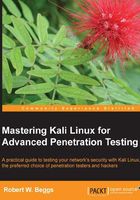
Conventions
In this book, you will find a number of styles of text that distinguish between different kinds of information. Here are some examples of these styles, and an explanation of their meaning.
Code words in text, database table names, folder names, filenames, file extensions, pathnames, dummy URLs, user input, and Twitter handles are shown as follows: "In this particular case, the VM has been assigned an IP address of 192.168.204.132."
A block of code is set as follows:
# MSF port scanner
onhost_add {
println("[*] MSF Port Scanner New Host OpenPorts on$1");
$console = console();
cmd($console, "use auxiliary/scanner/portscan/tcp");
cmd($console, "set THREADS 12");
cmd($console, "set PORTS 139, 143");
# enter other ports as required
cmd($console, "set RHOSTS $1");
cmd($console, "run -j");
cmd($console, "use auxiliary/scanner/discovery/udp_sweep");
cmd($console, "set THREADS 12");
cmd($console, "set BATCHSIZE 256");
cmd($console, "set RHOSTS $1");
cmd($console, "run -j");
db_sync();
}
Any command-line input or output is written as follows:
root@kali~# update-rc.d networking defaults
New terms and important words are shown in bold. Words that you see on the screen, in menus or dialog boxes for example, appear in the text like this: "If you double-click on the truecrypt1 icon, you will be taken to a File Browser view."